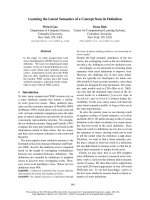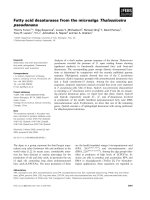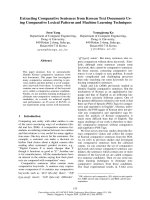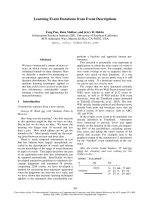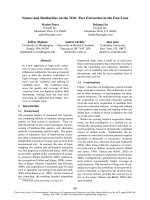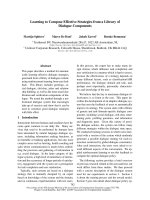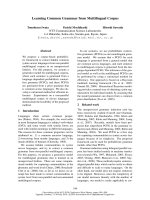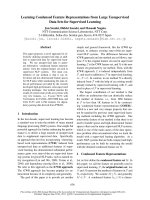Báo cáo khoa học: "Learning Transliteration Lexicons from the Web" pptx
Bạn đang xem bản rút gọn của tài liệu. Xem và tải ngay bản đầy đủ của tài liệu tại đây (423.42 KB, 8 trang )
Proceedings of the 21st International Conference on Computational Linguistics and 44th Annual Meeting of the ACL, pages 1129–1136,
Sydney, July 2006.
c
2006 Association for Computational Linguistics
Learning Transliteration Lexicons from the Web
Jin-Shea Kuo
1, 2
1
Chung-Hwa Telecom.
Laboratories, Taiwan
Haizhou Li
Institute for Infocomm
Research, Singapore
Ying-Kuei Yang
2
2
National Taiwan University of
Science and Technology, Taiwan
ntust.edu.tw
Abstract
This paper presents an adaptive learning
framework for Phonetic Similarity
Modeling (PSM) that supports the
automatic construction of transliteration
lexicons. The learning algorithm starts
with minimum prior knowledge about
machine transliteration, and acquires
knowledge iteratively from the Web. We
study the active learning and the
unsupervised learning strategies that
minimize human supervision in terms of
data labeling. The learning process
refines the PSM and constructs a
transliteration lexicon at the same time.
We evaluate the proposed PSM and its
learning algorithm through a series of
systematic experiments, which show that
the proposed framework is reliably
effective on two independent databases.
1 Introduction
In applications such as cross-lingual information
retrieval (CLIR) and machine translation (MT),
there is an increasing need to translate out-of-
vocabulary (OOV) words, for example from an
alphabetical language to Chinese. Foreign proper
names constitute a good portion of OOV words,
which are translated into Chinese through
transliteration. Transliteration is a process of
translating a foreign word into a native language
by preserving its pronunciation in the original
language, otherwise known as translation-by-
sound.
MT and CLIR systems rely heavily on
bilingual lexicons, which are typically compiled
manually. However, in view of the current
information explosion, it is labor intensive, if not
impossible, to compile a complete proper nouns
lexicon. The Web is growing at a fast pace and is
providing a live information source that is rich in
transliterations. This paper presents a novel
solution for automatically constructing an
English-Chinese transliteration lexicon from the
Web.
Research on automatic transliteration has
reported promising results for regular
transliteration (Wan and Verspoor, 1998; Li et al,
2004), where transliterations follow rigid
guidelines. However, in Web publishing,
translators in different countries and regions may
not observe common guidelines. They often
skew the transliterations in different ways to
create special meanings to the sound equivalents,
resulting in casual transliterations. In this case,
the common generative models (Li et al, 2004)
fail to predict the transliteration most of the time.
For example, “Coca Cola” is transliterated into
“ 可口可樂 /Ke-Kou-Ke-Le/” as a sound
equivalent in Chinese, which literately means
“happiness in the mouth”. In this paper, we are
interested in constructing lexicons that cover
both regular and casual transliterations.
When a new English word is first introduced,
many transliterations are invented. Most of them
are casual transliterations because a regular
transliteration typically does not have many
variations. After a while, the transliterations
converge into one or two popular ones. For
example, “Taxi” becomes “ 的士 /Di-Shi/” in
China and “ 德士 /De-Shi/” in Singapore.
Therefore, the adequacy of a transliteration entry
could be judged by its popularity and its
conformity with the translation-by-sound
principle. In any case, the phonetic similarity
should serve as the primary basis of judgment.
This paper is organized as follows. In Section
2, we briefly introduce prior works pertaining to
machine transliteration. In Section 3, we propose
a phonetic similarity model (PSM) for
confidence scoring of transliteration. In Section 4,
we propose an adaptive learning process for
PSM modeling and lexicon construction. In
Section 5, we conduct experiments to evaluate
different adaptive learning strategies. Finally, we
conclude in Section 6.
1129
2 Related Work
In general, studies of transliteration fall into two
categories: transliteration modeling (TM) and
extraction of transliteration pairs (EX) from
corpora.
The TM approach models phoneme-based or
grapheme-based mapping rules using a
generative model that is trained from a large
bilingual lexicon, with the objective of
translating unknown words on the fly. The
efforts are centered on establishing the phonetic
relationship between transliteration pairs. Most
of these works are devoted to phoneme
1
-based
transliteration modeling (Wan and Verspoor
1998, Knight and Graehl, 1998). Suppose that
EW is an English word and CW is its prospective
Chinese transliteration. The phoneme-based
approach first converts EW into an intermediate
phonemic representation P, and then converts the
phonemic representation into its Chinese
counterpart CW. In this way, EW and CW form
an E-C transliteration pair.
In this approach, we model the transliteration
using two conditional probabilities, P(CW|P) and
P(P|EW), in a generative model P(CW|EW) =
P(CW|P)P(P|EW). Meng (2001) proposed a rule-
based mapping approach. Virga and Khudanpur
(2003) and Kuo et al (2005) adopted the noisy-
channel modeling framework. Li et al (2004)
took a different approach by introducing a joint
source-channel model for direct orthography
mapping (DOM), which treats transliteration as a
statistical machine translation problem under
monotonic constraints. The DOM approach,
which is a grapheme-based approach,
significantly outperforms the phoneme-based
approaches in regular transliterations. It is noted
that the state-of-the-art accuracy reported by Li
et al (2004) for regular transliterations of the
Xinhua database is about 70.1%, which leaves
much room for improvement if one expects to
use a generative model to construct a lexicon for
casual transliterations.
EX research is motivated by information
retrieval techniques, where people attempt to
extract transliteration pairs from corpora. The
EX approach aims to construct a large and up-to-
date transliteration lexicon from live corpora.
Towards this objective, some have proposed
extracting translation pairs from parallel or
comparable bitext using co-occurrence analysis
1
Both phoneme and syllable based approaches are referred
to as phoneme-based here.
or a context-vector approach (Fung and Yee,
1998; Nie et al, 1999). These methods compare
the semantic similarities between words without
taking their phonetic similarities into accounts.
Lee and Chang (2003) proposed using a
probabilistic model to identify E-C pairs from
aligned sentences using phonetic clues. Lam et al
(2004) proposed using semantic and phonetic
clues to extract E-C pairs from comparable
corpora. However, these approaches are subject
to the availability of parallel or comparable
bitext. A method that explores non-aligned text
was proposed by harvesting katakana-English
pairs from query logs (Brill et al, 2001). It was
discovered that the unsupervised learning of such
a transliteration model could be overwhelmed by
noisy data, resulting in a decrease in model
accuracy.
Many efforts have been made in using Web-
based resources for harvesting transliteration/
translation pairs. These include exploring query
logs (Brill et al, 2001), unrelated corpus (Rapp,
1999), and parallel or comparable corpus (Fung
and Yee, 1998; Nie et al, 1999; Huang et al
2005). To establish correspondence, these
algorithms usually rely on one or more statistical
clues, such as the correlation between word
frequencies, cognates of similar spelling or
pronunciations. They include two aspects. First,
a robust mechanism that establishes statistical
relationships between bilingual words, such as a
phonetic similarity model which is motivated by
the TM research; and second, an effective
learning framework that is able to adaptively
discover new events from the Web. In the prior
work, most of the phonetic similarity models
were trained on a static lexicon. In this paper, we
address the EX problem by exploiting a novel
Web-based resource. We also propose a phonetic
similarity model that generates confidence scores
for the validation of E-C pairs.
In Chinese webpages, translated or
transliterated terms are frequently accompanied
by their original Latin words. The latter serve as
the appositives of the former. A sample search
result for the query submission “Kuro” is the
bilingual snippet
2
“ 經營 Kuro 庫洛 P2P 音樂交
換軟體的飛行網,3 日發表 P2P 與版權爭議的解
決方案— C2C (Content to Community) ”. The
co-occurrence statistics in such a snippet was
shown to be useful in constructing a transitive
translation model (Lu et al, 2002). In the
2
A bilingual snippet refers to a Chinese predominant text
with embedded English appositives.
1130
example above, “Content to Community” is not a
transliteration of C2C, but rather an acronym
expansion, while “庫洛 /Ku-Luo/”, as underlined,
presents a transliteration for “Kuro”. What is
important is that the E-C pairs are always closely
collocated. Inspired by this observation, we
propose an algorithm that searches over the close
context of an English word in a bilingual snippet
for the word’s transliteration candidates.
The contributions of this paper include: (i) an
approach to harvesting real life E-C
transliteration pairs from the Web; (ii) a phonetic
similarity model that evaluates the confidence of
so extracted E-C pair candidates; (iii) a
comparative study of several machine learning
strategies.
3 Phonetic Similarity Model
English and Chinese have different syllable
structures. Chinese is a syllabic language where
each Chinese character is a syllable in either
consonant-vowel (CV) or consonant-vowel-nasal
(CVN) structure. A Chinese word consists of a
sequence of characters, phonetically a sequence
of syllables. Thus, in first E-C transliteration, it
is a natural choice to syllabify an English word
by converting its phoneme sequence into a
sequence of Chinese-like syllables, and then
convert it into a sequence of Chinese characters.
There have been several effective algorithms
for the syllabification of English words for
transliteration. Typical syllabification algorithms
first convert English graphemes to phonemes,
referred to as the letter-to-sound transformation,
then syllabify the phoneme sequence into a
syllable sequence. For this method, a letter-to-
sound conversion is needed (Pagel, 1998;
Jurafsky, 2000). The phoneme-based
syllabification algorithm is referred to as PSA.
Another syllabification technique attempts to
map the grapheme of an English word to
syllables directly (Kuo and Yang, 2004). The
grapheme-based syllabification algorithm is
referred to as GSA. In general, the size of a
phoneme inventory is smaller than that of a
grapheme inventory. The PSA therefore requires
less training data for statistical modeling (Knight,
1998); on the other hand, the grapheme-based
method gets rid of the letter-to-sound conversion,
which is one of the main causes of transliteration
errors (Li et al, 2004).
Assuming that Chinese transliterations always
co-occur in proximity to their original English
words, we propose a phonetic similarity
modeling (PSM) that measures the phonetic
similarity between candidate transliteration pairs.
In a bilingual snippet, when an English word EW
is spotted, the method searches for the word’s
possible Chinese transliteration CW in its
neighborhood. EW can be a single word or a
phrase of multiple English words. Next, we
formulate the PSM and the estimation of its
parameters.
3.1 Generative Model
Let
1
{, , }
mM
ESeseses
= be a sequence of
English syllables derived from EW, using the
PSA or GSA approach, and
1
{, , }
nN
CScscscs
=
be the sequence of Chinese syllables derived
from CW, represented by a Chinese character
string
1
, , ,
nN
CWccc
® . EW and CW is a
transliteration pair. The E-C transliteration can
be considered a generative process formulated by
the noisy channel model, with EW as the input
and CW as the output.
(/)
PEWCW
is estimated
to characterize the noisy channel, known as the
transliteration probability.
()
PCW
is a language
model to characterize the source language.
Applying Bayes’ rule, we have
(/)(/)()/()
PCWEWPEWCWPCWPEW
= (1)
Following the translation-by-sound principle, the
transliteration probability
(/)
PEWCW
can be
approximated by the phonetic confusion
probability
(/)
PESCS
, which is given as
(/)max(,/),
PESCSPESCS
DÎF
=D
(2)
where
F
is the set of all possible alignment
paths between ES and CS. It is not trivial to find
the best alignment path
D
. One can resort to a
dynamic programming algorithm. Assuming
conditional independence of syllables in ES and
CS, we have
1
(/)(/)
M
mm
m
PESCSpescs
=
=
Õ
in a
special case where
MN
=
. Note that, typically,
we have
NM
£
due to syllable elision. We
introduce a null syllable
j
and a dynamic
warping strategy to evaluate
(/)
PESCS
when
MN
¹
(Kuo et al, 2005). With the phonetic
approximation, Eq.(1) can be rewritten as
(/)(/)()/()
PCWEWPESCSPCWPEW
» (3)
The language model in Eq.(3) can be
represented by Chinese characters n-gram
statistics.
121
1
()(/,, ,)
N
nnn
n
PCWpcccc
=
=
Õ
(4)
1131
In adopting bigram, Eq.(4) is rewritten as
11
2
()()(/)
N
nn
n
PCWpcpcc
-
=
»
Õ
. Note that the
context of EW usually has a number of
competing Chinese transliteration candidates in a
set, denoted as
W
. We rank the candidates by
Eq.(1) to find the most likely CW for a given EW.
In this process,
()
PEW
can be ignored because it
is the same for all CW candidates. The CW
candidate that gives the highest posterior
probability is considered the most probable
candidate
CW
¢
.
argmax(/)
argmax(/)()
CW
CW
CWPCWEW
PESCSPCW
ÎW
ÎW
¢
=
»
(5)
However, the most probable
CW
¢
isn’t
necessarily the desired transliteration. The next
step is to examine if
CW
¢
and EW indeed form a
genuine E-C pair. We define the confidence of
the E-C pair as the posterior odds similar to that
in a hypothesis test under the Bayesian
interpretation. We have
0
H
, which hypothesizes
that
CW
¢
and
EW
form an E-C pair, and
1
H
,
which hypothesizes otherwise. The posterior
odds is given as follows,
0
1
'
(/)
(/')(')
(/)
(/)()
CW
CWCW
PHEW
PESCSPCW
PHEW
PESCSPCW
s
ÎW
¹
=»
å
(6)
where
'
CS
is the syllable sequence of
CW
¢
,
1
(/)
pHEW
is approximated by the probability
mass of the competing candidates of
CW
¢
,
or
'
(/)()
CW
CWCW
PESCSPCW
ÎW
¹
å
. The higher the
s
is, the more probable that hypothesis
0
H
overtakes
1
H
. The PSM formulation can be
seen as an extension to prior work (Brill et al,
2001) in transliteration modeling. We introduce
the posterior odds
s
as the confidence score so
that E-C pairs that are extracted from different
contexts can be directly compared. In practice,
we set a threshold for
s
to decide a cutoff point
for E-C pairs short-listing.
3.2 PSM Estimation
The PSM parameters are estimated from the
statistics of a given transliteration lexicon, which
is a collection of manually selected E-C pairs in
supervised learning, or a collection of high
confidence E-C pairs in unsupervised learning.
An initial PSM is bootstrapped using prior
knowledge such as rule-based syllable mapping.
Then we align the E-C pairs with the PSM and
derive syllable mapping statistics for PSA and
GSA syllabifications. A final PSM is a linear
combination of the PSA-based PSM (PSA-PSM)
and the GSA-based PSM (GSA-PSM). The PSM
parameter
(/)
mn
pescs
can be estimated by an
Expectation-Maximization (EM) process
(Dempster, 1977). In the Expectation step, we
compute the counts of events such as
#,
mn
escs
<>
and #
n
cs
<>
by force-aligning the
E-C pairs in the training lexicon
Y
. In the
Maximization step, we estimate the PSM
parameters
(/)
mn
pescs
by
(/)#,/#
mnmnn
pescsescscs
=<><>
. (7)
As the EM process guarantees non-decreasing
likelihood probability
(/)
PESCS
"Y
Õ
, we let
the EM process iterate until
(/)
PESCS
"Y
Õ
converges. The EM process can be thought of as
a refining process to obtain the best alignment
between the E-C syllables and at the same time a
re-estimating process for PSM parameters. It is
summarized as follows.
Start: Bootstrap PSM parameters
(/)
mn
pescs
using prior phonetic mapping
knowledge
E-Step: Force-align corpus
Y
using existing
(/)
mn
pescs
and compute the counts of
#,
mn
escs
<>
and #
n
cs
<>
;
M-Step: Re-estimate
(/)
mn
pescs
using the
counts from E-Step.
Iterate: Repeat E-Step and M-Step until
(/)
PESCS
"Y
Õ
converges.
4 Adaptive Learning Framework
We propose an adaptive learning framework
under which we learn PSM and harvest E-C pairs
from the Web at the same time. Conceptually,
the adaptive learning is carried out as follows.
We obtain bilingual snippets from the Web by
iteratively submitting queries to the Web search
engines (Brin and Page, 1998). For each batch of
querying, the query results are all normalized to
plain text, from which we further extract
qualified sentences. A qualified sentence has at
least one English word. Under this criterion, a
collection of qualified sentences can be extracted
automatically. To label the E-C pairs, each
qualified sentence is manually checked based on
the following transliteration criteria: (i) if an EW
is partly translated phonetically and partly
translated semantically, only the phonetic
transliteration constituent is extracted to form a
1132
transliteration pair; (ii) elision of English sound
is accepted; (iii) multiple E-C pairs can appear in
one sentence; (iv) an EW can have multiple valid
Chinese transliterations and vice versa. The
validation process results in a collection of
qualified E-C pairs, also referred to as Distinct
Qualified Transliteration Pairs (DQTPs).
As formulated in Section 3, the PSM is trained
using a training lexicon in a data driven manner.
It is therefore very important to ensure that in the
learning process we have prepared a quality
training lexicon. We establish a baseline system
using supervised learning. In this approach, we
use human labeled data to train a model. The
advantage is that it is able to establish a model
quickly as long as labeled data are available.
However, this method also suffers from some
practical issues. First, the derived model can only
be as good as the data that it sees. An adaptive
mechanism is therefore needed for the model to
acquire new knowledge from the dynamically
growing Web. Second, a massive annotation of
database is labor intensive, if not entirely
impossible.
To reduce the annotation needed, we discuss
three adaptive strategies cast in the machine
learning framework, namely active learning,
unsupervised learning and active-unsupervised
learning. The learning strategies can be depicted
in Figure 1 with their difference being discussed
next. We also train a baseline system using
supervised learning approach as a reference point
for benchmarking purpose.
4.1 Active Learning
Active learning is based on the assumption that a
small number of labeled samples, which are
DQTPs here, and a large number of unlabeled
Figure 1. An adaptive learning framework for
automatic construction of transliteration lexicon.
samples are available. This assumption is valid in
most NLP tasks. In contrast to supervised
learning, where the entire corpus is labeled
manually, active learning selects the most useful
samples for labeling and adds the labeled
examples to the training set to retrain the model.
This procedure is repeated until the model
achieves a certain level of performance.
Practically, a batch of samples is selected each
time. This is called batch-based sample selection
(Lewis and Catlett, 1994), as shown in the search
and ranking block in Figure 1.
For an active learning to be effective, we
propose using three measures to select candidates
for human labeling. First, we would like to select
the most uncertain samples that are potentially
highly informative for the PSM model. The
informativeness of a sample can be quantified by
its confidence score
s
as in the PSM
formulation. Ranking the E-C pairs by
s
is
referred to as C-rank. The samples of low C-rank
are the interesting samples to be labeled. Second,
we would like to select candidates that are of low
frequency. Ranking by frequency is called F-
rank. During Web crawling, most of the search
engines use various strategies to prevent
spamming and one of fundamental tasks is to
remove the duplicated Web pages. Therefore, we
assume that the bilingual snippets are all unique.
Intuitively, E-C pairs of low frequency indicate
uncommon events which are of higher interest to
the model. Third, we would like to select
samples upon which the PSA-PSM and GSA-
PSM disagree the most. The disagreed upon
samples represent new knowledge to the PSM. In
short, we select low C-rank, low F-rank and
PSM-disagreed samples for labeling because the
high C-rank, high F-rank and PSM-agreed
samples are already well known to the model.
4.2 Unsupervised Learning
Unsupervised learning skips the human labeling
step. It minimizes human supervision by
automatically labeling the data. This can be
effective if prior knowledge about a task is
available, for example, if an initial PSM can be
built based on human crafted phonetic mapping
rules. This is entirely possible. Kuo et al (2005)
proposed using a cross-lingual phonetic
confusion matrix resulting from automatic
speech recognition to bootstrap an initial PSM
model. The task of labeling samples is basically
to distinguish the qualified transliteration pairs
from the rest. Unlike the sample selection
method in active learning, here we would like to
Iterate
Start
Final
PSM
Initial
PSM
Search &
Ranking
PSM
Learning
Lexicon
Stop
The Web
Select &
Labeling
Training
Samples
Labeled
Samples
PSM
Evaluation & Stop
C
riterion
1133
select the samples that are of high C-rank and
high F-rank because they are more likely to be
the desired transliteration pairs.
The difference between the active learning and
the unsupervised learning strategies lies in that
the former selects samples for human labeling,
such as in the select & labeling block in Figure 1
before passing on for PSM learning, while the
latter selects the samples automatically and
assumes they are all correct DQTPs. The
disadvantage of unsupervised learning is that it
tends to reinforce its existing knowledge rather
than to discover new events.
4.3 Active-Unsupervised Learning
The active learning and the unsupervised
learning strategies can be complementary. Active
learning minimizes the labeling effort by
intelligently short-listing informative and
representative samples for labeling. It makes sure
that the PSM learns new and informative
knowledge over iterations. Unsupervised
learning effectively exploits the unlabelled data.
It reinforces the knowledge that PSM has
acquired and allows PSM to adapt to changes at
no cost. However, we do not expect
unsupervised learning to acquire new knowledge
like active learning does. Intuitively, a better
solution is to integrate the two strategies into one,
referred to as the active-unsupervised learning
strategy. In this strategy, we use active learning
to select a small amount of informative and
representative samples for labeling. At the same
time, we select samples of high confidence score
from the rest and consider them correct E-C pairs.
We then merge the labeled set with the high-
confidence set in the PSM re-training.
5 Experiments
We first construct a development corpus by
crawling of webpages. This corpus consists of
about 500 MB of webpages, called SET1 (Kuo et
al, 2005). Out of 80,094 qualified sentences,
8,898 DQTPs are manually extracted from SET1,
which serve as the gold standard in testing. To
establish a baseline system, we first train a PSM
using all 8,898 DQTPs in supervised manner and
conduct a closed test on SET1 as in Table 1. We
further implement three PSM learning strategies
and conduct a systematic series of experiments.
Precision
Recall
F-measure
closed-test
0.79 0.69 0.74
Table 1. Supervised learning test on SET1
5.1 Unsupervised Learning
We follow the formulation described in
Section 4.2. First, we derive an initial PSM using
randomly selected 100 seed DQTPs and simulate
the Web-based learning process with the SET1:
(i) select high F-rank and high C-rank E-C pairs
using PSM, (ii) add the selected E-C pairs to the
DQTP pool as if they are true DQTPs, and (iii)
reestimate PSM by using the updated DQTP pool.
In Figure 2, we report the F-measure over
iterations. The U_HF curve reflects the learning
progress of using E-C pairs that occur more than
once in the SET1 corpus (high F-rank). The
U_HF_HR curve reflects the learning progress
using a subset of E-C pairs from U_HF which
has high posterior odds as defined in Eq.(6).
Both selection strategies aim to select E-C pairs,
which are as genuine as possible.
0
0.1
0.2
0.3
0.4
0.5
0.6
0.7
0.8
1 2 3 4 5 6
# Iteration
F-measure
Supervised
U_HF
U_HF_HR
Figure 2. F-measure over iterations for
unsupervised learning on SET1.
We found that both U_HF and U_HF_HR give
similar results in terms of F-measure. Without
surprise, more iterations don’t always lead to
better performance because unsupervised
learning doesn’t aim to acquiring new knowledge
over iterations. Nevertheless, unsupervised
learning improves the initial PSM in the first
iteration substantially. It can serve as an effective
PSM adaptation method.
5.2 Active Learning
The objective of active learning is to minimize
human supervision by automatically selecting the
most informative samples to be labeled. The
effect of active learning is that it maximizes
performance improvement with minimum
annotation effort. Like in unsupervised learning,
we start with the same 100 seed DQTPs and an
initial PSM model and carry out experiments on
SET1: (i) select low F-rank, low C-rank and
GSA-PSM and PSA-PSM disagreed E-C pairs;
(ii) label the selected pairs by removing the non-
E-C pairs and add the labeled E-C pairs to the
DQTP pool, and (iii) reestimate the PSM by
using the updated DQTP pool.
1134
To select the samples, we employ 3 different
strategies: A_LF_LR, where we only select low
F-rank and low C-rank candidates for labeling.
A_DIFF, where we only select those that GSA-
PSM and PSA-PSM disagreed upon; and
A_DIFF_LF_LR, the union of A_LF_LR and
A_DIFF selections. As shown in Figure 3, the F-
measure of A_DIFF (0.729) and
A_DIFF_LF_LR (0.731) approximate to that of
supervised learning 0.735) after four iterations.
0
0.1
0.2
0.3
0.4
0.5
0.6
0.7
0.8
1 2 3 4 5 6
# Iteration
F-measure
Supervised
A_LF_LR
A_DIFF
A_DIFF_LF_LR
Figure 3. F-measure over iterations for active
learning on SET1.
With almost identical performance as
supervised learning, the active learning approach
has greatly reduced the number of samples for
manual labeling as reported in Table 2. It is
found that for active learning to reach the
performance of supervised learning, A_DIFF is
the most effective strategy. It reduces the
labeling effort by 89.0%, from 80,094 samples to
8,750.
Sample selection #samples labeled
A_LF_LR 1,671
A_DIFF 8,750
Active
learning
A_DIFF_LF_LR 9,683
Supervised learning 80,094
Table 2. Number of total samples for manual
labeling in 6 iterations of Figure 3.
5.3 Active Unsupervised Learning
It would be interesting to study the performance
of combining unsupervised learning and active
learning. The experiment is similar to that of
active learning except that, in step (iii) of active
learning, we take the unlabeled high confidence
candidates (high F-rank and high C-rank as in
U_HF_HR of Section 5.1) as the true labeled
samples and add into the DQTP pool. The result
is shown in Figure 4. Although active
unsupervised learning was reported having
promising results (Riccardi and Hakkani-Tur,
2003) in some NLP tasks, it has not been as
effective as active learning alone in this
experiment probably due to the fact the
unlabeled high confidence candidates are still too
noisy to be informative.
0
0.1
0.2
0.3
0.4
0.5
0.6
0.7
0.8
1 2 3 4 5 6
# Iteration
F-measure
Supervised
AU_LF_LR
AU_DIFF
AU_DIFF_LF_LR
Figure 4. F-measure over iterations for active
unsupervised learning on SET1.
5.4 Learning Transliteration Lexicons
The ultimate objective of building a PSM is to
extract a transliteration lexicon from the Web by
iteratively submitting queries and harvesting new
transliteration pairs from the return results until
no more new pairs. For example, by submitting
“Robert” to search engines, we may get “Robert-
羅伯特”, “Richard-理查” and “Charles-查爾斯”
in return. In this way, new queries can be
generated iteratively, thus new pairs are
discovered. We pick the best performing SET1-
derived PSM trained using A_DIFF_LF_LR
active learning strategy and test it on a new
database SET2 which is obtained in the same
way as SET1.
Before
adaptation
After
adaptation
#distinct E-C pairs 137,711 130,456
Precision 0.777 0.846
#expected DQTPs 107,001 110,365
Table 3. SET1-derived PSM adapted towards
SET2.
SET2 contains 67,944 Web pages amounting
to 3.17 GB. We extracted 2,122,026 qualified
sentences from SET2. Using the PSM, we extract
137,711 distinct E-C pairs. As the gold standard
for SET2 is unavailable, we randomly select
1,000 pairs for manual checking. A precision of
0.777 is reported. In this way, 107,001 DQTPs
can be expected. We further carry out one
iteration of unsupervised learning using
U_HF_HR to adapt the SET1-derived PSM
towards SET2. The results before and after
adaptation are reported in Table 3. Like the
experiment in Section 5.1, the unsupervised
learning improves the PSM in terms of precision
significantly.
1135
6 Conclusions
We have proposed a framework for harvesting E-
C transliteration lexicons from the Web using
bilingual snippets. In this framework, we
formulate the PSM learning and E-C pair
evaluation methods. We have studied three
strategies for PSM learning aiming at reducing
the human supervision.
The experiments show that unsupervised
learning is an effective way for rapid PSM
adaptation while active learning is the most
effective in achieving high performance. We find
that the Web is a resourceful live corpus for real
life E-C transliteration lexicon learning,
especially for casual transliterations. In this
paper, we use two Web databases SET1 and
SET2 for simplicity. The proposed framework
can be easily extended to an incremental learning
framework for live databases. This paper has
focused solely on use of phonetic clues for
lexicon and PSM learning. We have good reason
to expect the combining semantic and phonetic
clues to improve the performance further.
References
E. Brill, G. Kacmarcik, C. Brockett. 2001.
Automatically Harvesting Katakana-English Term
Pairs from Search Engine Query Logs, In Proc. of
NLPPRS, pp. 393-399.
S. Brin and L. Page. 1998. The Anatomy of a Large-
scale Hypertextual Web Search Engine, In Proc
.
of
7
th
WWW, pp. 107-117.
A. P. Dempster, N. M. Laird and D. B. Rubin. 1977.
Maximum Likelihood from Incomplete Data via
the EM Algorithm, Journal of the Royal Statistical
Society, Ser. B. Vol. 39, pp. 1-38.
P. Fung and L Y. Yee. 1998. An IR Approach for
Translating New Words from Nonparallel,
Comparable Texts. In Proc. of 17
th
COLING and
36
th
ACL, pp. 414-420.
F. Huang, Y. Zhang and Stephan Vogel. 2005. Mining
Key Phrase Translations from Web Corpora. In
Proc. of HLT-EMNLP, pp. 483-490.
D. Jurafsky and J. H. Martin. 2000. Speech and
Language Processing, pp. 102-120, Prentice-Hall,
New Jersey.
K. Knight and J. Graehl. 1998. Machine
Transliteration, Computational Linguistics, Vol. 24,
No. 4, pp. 599-612.
J S. Kuo and Y K. Yang. 2004. Constructing
Transliterations Lexicons from Web Corpora, In
the Companion Volume, 42
nd
ACL, pp. 102-105.
J S. Kuo and Y K. Yang. 2005. Incorporating
Pronunciation Variation into Extraction of
Transliterated-term Pairs from Web Corpora, In
Proc. of ICCC, pp. 131-138.
C J. Lee and J S. Chang. 2003. Acquisition of
English-Chinese Transliterated Word Pairs from
Parallel-Aligned Texts Using a Statistical Machine
Transliteration Model, In Proc. of HLT-NAACL
Workshop Data Driven MT and Beyond, pp. 96-
103.
D. D. Lewis and J. Catlett. 1994. Heterogeneous
Uncertainty Sampling for Supervised Learning, In
Proc. of ICML 1994, pp. 148-156.
H. Li, M. Zhang and J. Su. 2004. A Joint Source
Channel Model for Machine Transliteration, In
Proc. of 42
nd
ACL, pp. 159-166.
W. Lam, R Z. Huang and P S. Cheung. 2004.
Learning Phonetic Similarity for Matching Named
Entity Translations and Mining New Translations,
In Proc. of 27
th
ACM SIGIR, pp. 289-296.
W H. Lu, L F. Chien and H J Lee. 2002.
Translation of Web Queries Using Anchor Text
Mining, TALIP, Vol. 1, Issue 2, pp. 159- 172.
H. M. Meng, W K. Lo, B. Chen and T. Tang. 2001.
Generate Phonetic Cognates to Handle Name
Entities in English-Chinese Cross-Language
Spoken Document Retrieval, In Proc. of ASRU, pp.
311-314.
J Y. Nie, P. Isabelle, M. Simard, and R. Durand.
1999. Cross-language Information Retrieval based
on Parallel Texts and Automatic Mining of Parallel
Text from the Web”, In Proc. of 22
nd
ACM SIGIR,
pp 74-81.
V. Pagel, K. Lenzo and A. Black. 1998. Letter to
Sound Rules for Accented Lexicon Compression,
In Proc. of ICSLP, pp. 2015-2020.
R. Rapp. 1999. Automatic Identification of Word
Translations from Unrelated English and German
Corpora, In Proc. of 37
th
ACL, pp. 519-526.
G. Riccardi and D. Hakkani-Tür. 2003. Active and
Unsupervised Learning for Automatic Speech
Recognition. In Proc. of 8
th
Eurospeech.
P. Virga and S. Khudanpur. 2003. Transliteration of
Proper Names in Cross-Lingual Information
Retrieval, In Proc. of 41
st
ACL Workshop on
Multilingual and Mixed Language Named Entity
Recognition, pp. 57-64.
S. Wan and C. M. Verspoor. 1998. Automatic
English-Chinese Name Transliteration for
Development of Multilingual Resources, In Proc. of
17
th
COLING and 36
th
ACL, pp.1352-1356.
1136

